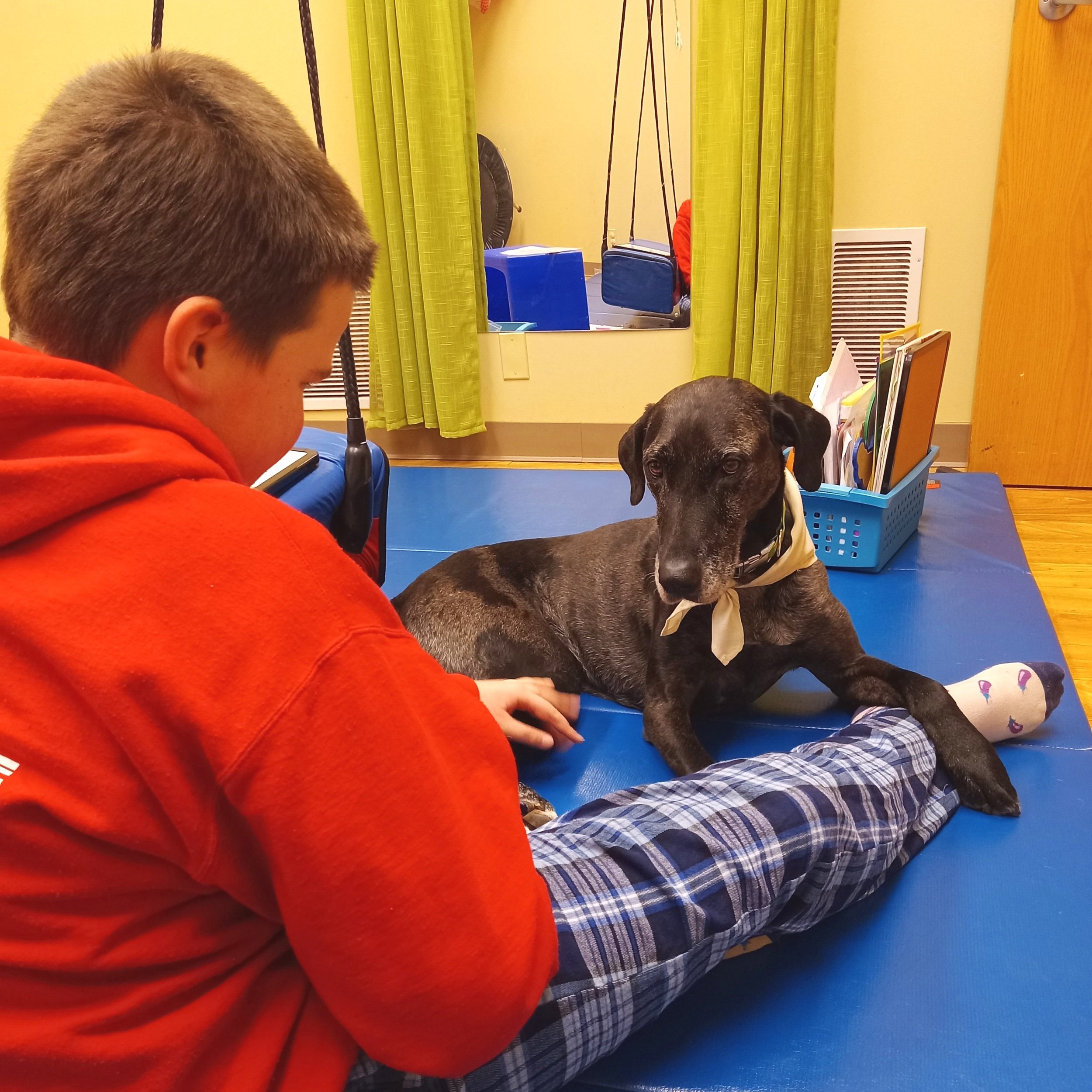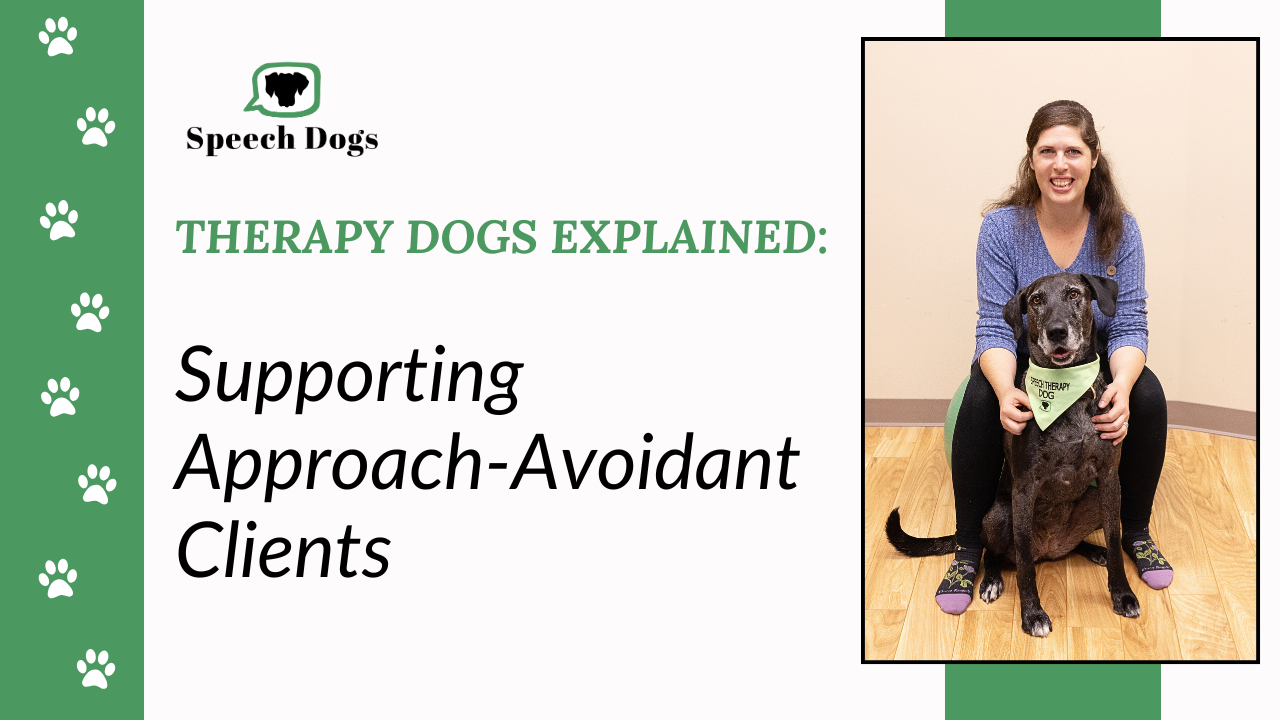When a Therapy Dog Brings Worries: Helping Kids Overcome Mild Fears During Animal-Assisted Speech Therapy
David squealed with delight every time my speech therapy dog Delta moved, but then ran to his mom if Delta approached.
Nellie asked to give Delta treats, but then jerked her hand away when Delta’s mouth touched her palm.
When Delta approached calmly, Ishak hid behind his Dad, who backed away explaining he had “given” his son a fear of dogs.
While therapy dogs bring a lot of gifts to animal-assisted speech therapy, not all children and caregivers are immediately comfortable in their presence. As an SLP, it helps to identify why a child is uneasy to determine if some desensitization and/or education can enable the speech therapy dog to become a useful active component of therapy, will need to simply wait quietly during this child’s sessions, or would be better contained away from the child.
Therapy dog Delta snuggles with a familiar child during animal-assisted speech therapy. While this boy is obviously comfortable in a dog’s presence, some children are not and will need special considerations when a therapy dog is on-site.
If you click a link, it is likely an affiliate link and I will earn a small commission. There is no extra cost for you. If I don’t love and use the product, you won’t find it here!
I’ve seen three categories of fears when it comes to the presence of a therapy dog in an animal-assisted speech therapy session:
-Lack of experience
-Sensory overwhelm
-Negative past experiences
Let’s explore each a bit more and so I can share what I’ve found helps.
Ultimately, keep in mind that as an SLP your ethical obligation is to the patient, so if a child or caregiver’s fear is severe enough that it will negatively impact the child’s ability to make progress and/or cause further trauma, it is imperative to either keep your speech therapy dog out of those sessions entirely (at home or in a closed, safe area away from the family) or explore with the caregivers if a different area provider might be a better fit.
Lack of experience with dogs
I’ve seen this both with kids coming from non-pet owning homes and kids with cultural influences that impact how they view dogs. Also, my own speech therapy dog is fairly large (Great Dane/Labrador mix), so some children are simply used to smaller pets at home or in the neighborhood.
Like with other communication skills we teach, an SLP can break down skills related to petting and handling the therapy dog into smaller steps to gradually desensitize an anxious child. In this situation I typically:
· Keep the therapy dog out of the room when initially building rapport and completing any standardized testing, so as not to influence test performance with distractions or anxiety
· Encourage a willing caregiver or sibling to model petting and/or feeding treats
· Allow the child to toss treats across the room for the therapy dog to retrieve so they can see the dog move without the pressure of direct contact
· Use a running dialogue, suited to the child’s receptive language abilities, about the therapy dog (e.g., “Delta is sitting, nice doggie, so quiet”; “Delta loves treats. I’m going to feed her. She’s slobbery. Silly dog.”). This helps provide a soothing distraction as the child adjusts to being in the presence of a dog.
· Teach the child how to direct the therapy dog so they have a sense of control, such as commanding the dog to go to her bed or putting a hand up to signal a need for space.
Sensory overwhelm around a speech therapy dog
Many children receiving speech and language therapy also have sensory processing differences that can make them react strongly to sights/sounds/smells/touch. In some cases, they may be more hypersensitive on some days than others, requiring ongoing assessment of the situation and adjusting of plans as needed.
In addition to the tools above, I generally try to find a way for the child to interact less directly, such as:
· Asking the child to place his or her hand under mine as I feed the therapy dog a treat, allowing them to be a part of the activity without the overwhelm of a wet nose or slobber touching them.
The same technique can be used to “shake hands” with the therapy dog, as a dog’s rough paw pads may cause a strong reaction. (For my favorite non-smelly/non-sticky dog treat to use with sensitive kids, click here.)
· Keeping any active participation by the therapy dog slow-paced and calm (alternatively, some children who are hyposensitive might benefit from high-energy fetch games or taking turns racing through a tunnel to become more alert during a session).
This can also be good time for the dog to be in a stay on a bed, in a crate, or behind a barrier so they can be seen and heard moving about without the possibility of unexpected touch.
· Model petting with long, slow strokes down the therapy dog’s back, where the hair tends to be smoothest and most tolerable to someone who is sensitive to the feel of items. This is also generally the most comfortable for the therapy dog, helping ensure safe interactions.
To view video of a speech therapy client demonstrating approach-avoidant behaviors due to both lack of experience with dogs in general and sensory overwhelm, click here.
An episode of Therapy Dogs Explained from the Speech Dogs YouTube channel demonstrates the tips listed above for helping a child with sensory overwhelm and lack of experience around dogs. It includes ideas for supporting the speech therapy dog in this situation as well, as they may become stressed by approach-avoidant behaviors.
Negative experiences with a dog
In some cases, a child or their family member has been bitten by a dog or lived in an environment where dogs were used aggressively for protection, fighting, policing, etc..
If the child and family are interested in overcoming this fear (they may not be, especially if staying away from known aggressive dogs is adaptive in their environment or it is part of their family’s culture), the tips above may come in handy.
I have only personally dealt with one case of severe dog fear, and in that case the entire family was comfortable with a speech therapy dog being in the office as long as she was behind a closed door or on leash. I just called it “nap time” and had a special long-lasting chew toy available so no-one felt bad the dog was being left out (a Kong toy filled with sunflower butter or smaller treats is one great option).
Because my therapy dogs enjoy their work, they often seem confused or a little stressed when needing to be separated. Adding a spritz of Dog Appeasing Phermone to their rest area helps them relax more and take advantage of this down time.
If families are interested in more information, Overcoming Your Child’s Fear of Dogs is an excellent resource.
Effects of children’s anxiety on the speech therapy dog
It’s important to remember that dogs are sensitive to body language and may become stressed if a child is repeatedly pulling away or becoming agitated in their presence.
Since therapy dogs are by their nature very affiliative, meaning they seek out human attention, they may not be sure how to act around someone that is reluctant to interact.
I have found my speech therapy dogs get the most stressed by kids who exhibit frequent approach-avoidant behavior, reaching out for the dog and then jerking back.
Watching for appeasement signals (e.g., the dog raising a foot, ears pulling back, nervous tail wags) can help you know if you need to calm the therapy dog and/or remove them from the situation. My favorite resource for learning about body language is the DVD The Language of Dogs which provides lots of video clips of different breeds of dogs exhibiting various signs of stress to learn what to watch for.
A few helpful obedience skills for a speech therapy dog include:
· staying independently on a safe spot (bed, crate, rug) even when there is activity going on
· waiting in place and/or backing up when a hand is held out
· taking treats calmly and politely
Therapy dogs have the potential to bring so much joy when interacting with children with their families in animal-assisted speech therapy. Using the tips above can help you be a better partner with your therapy dog in situations where a client is mildly nervous.
If you found this post helpful, please follow on Instagram @Speech_Dogs and check back for updates on Paws for Progress: Integrating Animal-Assisted Interventions Into Your Speech-Language Pathology Practice, coming from ASHA Press in Fall of ‘24.
May your day be filled with puppy wiggles and children’s giggles,
Sharlet



